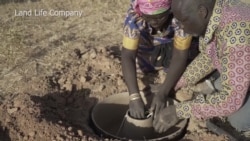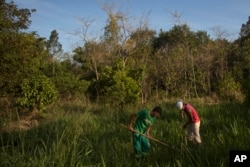There’s money to be made planting trees, according to a new report.
Around the world, an area larger than all of South America has been deforested, eroded, drained or salinized.
Governments have pledged billions to restore hundreds of millions of hectares.
What’s missing are the businesses to make it happen.
WATCH: Report Sees Profit in Restoring Degraded Land
The new report, called “The Business of Planting Trees,” aims to make the case to reluctant investors that restoring the world’s 2 billion hectares of degraded land represents an untapped opportunity.
With demands on land rising and climate change closing in, the world needs every hectare to produce food, clean the air and water, and soak up greenhouse gases, experts say.
A group of 47 countries worldwide have committed to restore a Mongolia-sized chunk of degraded land by 2020. African and Latin American investors have pledged $2 billion to restoration.
“Now that the pledges are on the table, the question is, how do we convert this into action?” asked report lead author Sofia Faruqi at the World Resources Institute.
Governments and NGOs can’t do it all, she said. The task needs the private sector. And that means there needs to be profits.
The report focuses on 14 companies aiming to make money restoring land. The authors wanted business models that could make a substantial impact.
“Given the urgency of the challenge, we’re really looking for solutions that are going to be big,” Faruqi said.
Clear-cuts to rosewood
When it comes to planting trees, the Brinkman Group is one of the biggest.
Over the last five decades, Brinkman has planted 1.4 billion trees on 1 million hectares of land. The company got its start replanting clear-cut forests in Canada.
In the 1990s, it started growing trees on previously slashed-and-burned land in Central America.
Brinkman created a diverse forest habitat with a mix of trees, including teak for furniture and flooring and rosewood for guitars. To preserve that habitat, trees would be selectively cut, not clear-cut, at harvest time.
Some species were not typically grown commercially. It took years to learn how to grow them from cuttings.
But two decades later, the work is beginning to pay off. The first harvests are beginning. Company founder Dirk Brinkman says they are making a 10 percent return on their investment.
“It’s a bit surprising for some looking at this, that this is possible,” he said. “But it takes time to prove.”
Other companies featured in the report are lowering the cost of restoration.
BioCarbon Engineering flies drones that plant trees. Drones are faster and cheaper than replanting by hand, the company says, and can reach hard-to-reach sites.
Others tap into consumer demand for forest-friendly products.
Guayakí sells canned tea made from shade-grown yerba mate. The company has planted a half-million trees in Brazil’s heavily degraded Atlantic forest to shade its cash crop.
The report includes some novel business models.
Growing demand for building materials and charcoal are driving deforestation in much of Africa.
A Kenya-based company called Komaza is “connecting the dots from smallholder farmers to the massive, booming wood markets of Africa, which the farmers wouldn’t otherwise have access to,” said company president Ayesha Wagle.
Komaza gives smallholder farmers tree seedlings to plant on unused parts of their land. When the trees mature in 10 to 12 years, Komaza buys the trees back for a guaranteed price. The company harvests, processes and sells the wood.
More than 9,000 farmers are raising more than 2 million trees for Komaza.
Risky business
The company has not yet turned a profit.
“Trees take a long time to grow,” Wagle said. “We could chop down a whole bunch of trees today and be profitable. But ... the longer we wait, the more valuable they are.”
The long time to returns is one of the drawbacks for some investors, Faruqi said.
For Komaza, “there are a whole host of challenges, from rainy seasons that don’t appear, to poor roads that make it hard to truck trees to market,” Wagle said.
Land ownership is unclear in many developing countries, which can make investing in farmers and land restoration risky.
And government policy may change over the course of the investment, especially in developing countries.
When Brinkman’s company planted its tropical hardwoods, “We were promised a tax-free harvest,” he said. “Twenty years later, the bureaucracy is going, ‘No, no, we tax logging.’ And we’re going, ‘No, no, we’ve got a grandfathered agreement.’ ‘Oh, well, we don’t have a copy of that agreement anymore.’”
It took several years to straighten out the dispute.
What WRI calls the “restoration economy” is relatively new. When it comes to potential risks and rewards, “there’s not much hard data out there,” said Yale University economics professor Mushfiq Mobarak, “which is probably why investors are staying away.”
The new report may serve as a catalyst for more study, Mobarak said, but he noted that the data came from the companies themselves.
“I’m glad that the ideas are now out there,” he said. “However, I’d prefer to see a next step” of more independent research.

















